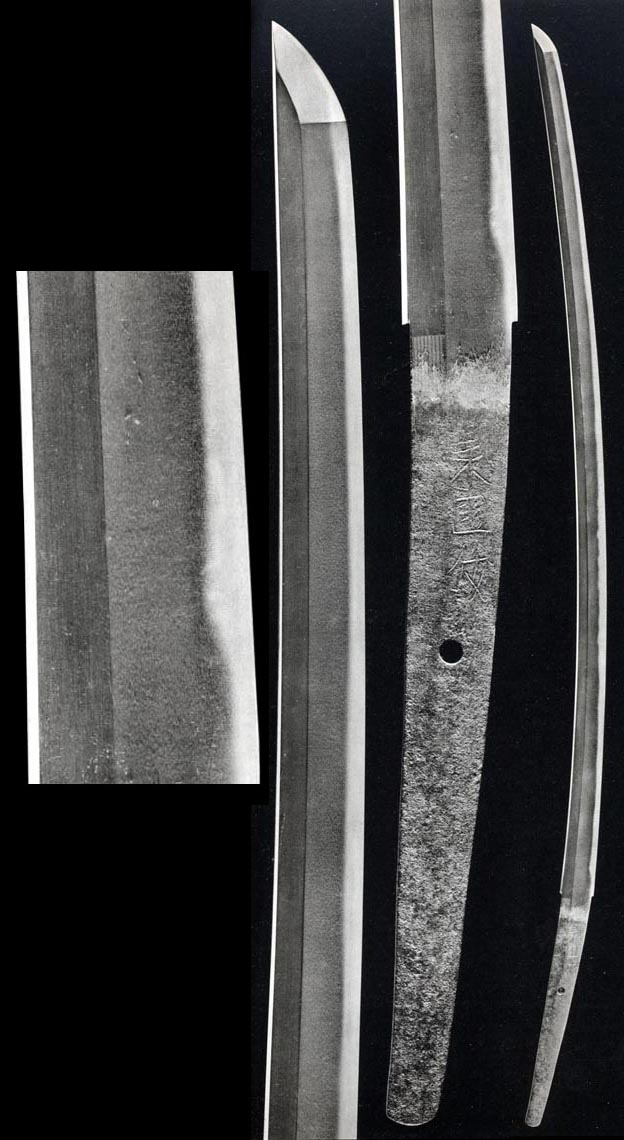Notes on the differences between
NIJI and SANJI KUNITOSHI
NIJI Two-characters KUNITOSHI made the bold style of his
middle-late KAMAKURA peers. Strong, with little tapering
in width.
(Note: FUNBARI is a term, properly used to describe
the HEIAN SUGATA trait of overt width at the base.
HEIAN FUNBARI was exemplified by the convergence to
a very small KO-KISSAKI. FUNBARI has become commonly
used to describe any noticeable difference in width
between the upper and lower. This is technically
incorrect, although common to the tongue. As it is
colloquial, one should know the difference and make
sure in the speaking)
NIJI's work was seated to his peers and style of the
mid-KAMAKURA, fully expanded upper. Differential in width
had receded steadily until the 2nd generation FUKUOKA
ICHIMONJI pushed SUGATA and YAKIBA to their limits around
KEN-CHO 1249.
This zenith of mid-KAMAKURA expansion stayed through
BUN-EI 1264, where we see a refining. Both SUGATA and
YAKIBA become more defined and deliberate.
KYOTO, the always city, had always produced the highest
development and sophistication of arts and literature.
KYOTO refinement was withdrawal from overbearance -
without weakness. Born of the aristocracy, the essence
of the Japanese soul was searched and researched in the
capital provinces.
RAI swords and schools reflect this.
While the FUKUOKA pushed all parameters to an extreme,
YAMASHIRO sword makers articulated their always tasteful
sophistication and reserve.
The SUGATA of NIJI KUNITOSHI shows the display of
mid-KAMAKURA roots and domain. MAGOTARO, conversely,
creates the SUGATA of the "coming" time.
There has been confusion in reference because there
appears to be no over-lap. It would seem possible for a
new leader to appear suddenly in the midst of an otherwise
strong career, but in such cases it would be expected to
see the early works of the new master before the passing
of the senior.
Sometimes a protege would help the master until old age
before making swords under his own name, NAGAMOTO helping
his master, OSAFUNE NAGAMITSU is the example.
The strength of MAGOTARO is seen by his recall from the
long past HEIAN, a new FUNBARI and with it, a new direction
for the whole of the country.
The KEN-CHO 1249 mid-KAMAKURA expansion of width was most
similar with the even width of the NAMBOKUCHO.
MAGOTARO's post mid-KAMAKURA FUNBARI played off the theme
of HEIAN SUGATA just as NAMBOKUCHO mimicked the expansion
of mid-KAMAKURA.
MAGOTARO KUNITOSHI created and led the retreat from the
full SUGATA of his father's mid-KAMAKURA roots.
His style departure was not created to counter his father.
His was the strong stroke of the great master. He did not
just change direction, but created the direction.
His narrower SUGATA has no weakness, the upper has
complete power.
MAGOTARO = "Coming" of new style. |



